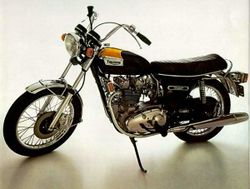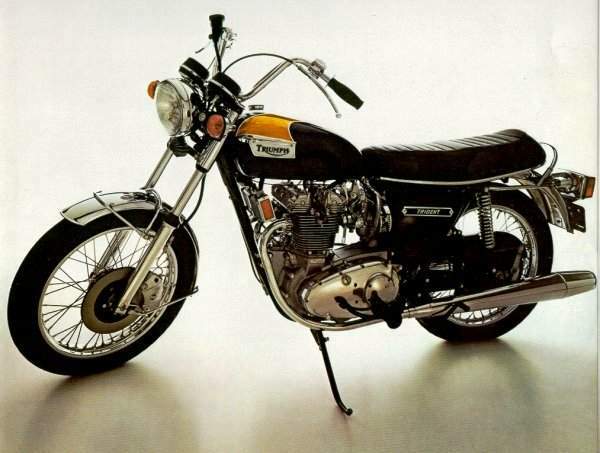Triumph V
 |
|
| Triumph V | |
| Manufacturer | |
|---|---|
| Production | 1974 |
| Engine | Tansverse three cylinder, pushrod OHV, 2 valves per cylinder |
| Compression ratio | 9.1:1 |
| Top Speed | 194 km/h / 121 mph |
| Ignition | Individual points & coils |
| Transmission | 5-Speed, constant mesh |
| Frame | Dual downtube steel cradle |
| Suspension | Front: Telescopic fork, hydraulic, oil damped Rear: Swingarm, dual shocks, hydraulic dampers, adjustable preload |
| Brakes | Front: 10 in Hydraulic disc Rear: 8 in SLS drum in conical hub |
| Front Tire | 3.25-19, Dunlop K70 |
| Rear Tire | 4.10-19, Dunlop K70 |
| Wheelbase | 1448 mm / 57 in |
| Seat Height | 813 mm / 32 in |
| Weight | 209 kg / 460 lbs (dry), 228 kg / 503 lbs (wet) |
| Fuel Capacity | 9 L / 5.0 US gal / 4.2 Imp gal |
| Manuals | Service Manual |
It could reach a top speed of 194 km/h / 121 mph.
Engine[edit | edit source]
The engine was a Air cooled cooled Tansverse three cylinder, pushrod OHV, 2 valves per cylinder. The engine featured a 9.1:1 compression ratio.
Drive[edit | edit source]
Power was moderated via the Single plate, dry, diaphragm type.
Chassis[edit | edit source]
It came with a 3.25-19, Dunlop K70 front tire and a 4.10-19, Dunlop K70 rear tire. Stopping was achieved via 10 in Hydraulic disc in the front and a 8 in SLS drum in conical hub in the rear. The front suspension was a Telescopic fork, hydraulic, oil damped while the rear was equipped with a Swingarm, dual shocks, hydraulic dampers, adjustable preload. The V was fitted with a 9 L / 5.0 US gal / 4.2 Imp gal fuel tank. The bike weighed just 209 kg / 460 lbs. The wheelbase was 1448 mm / 57 in long.
Photos[edit | edit source]
Overview[edit | edit source]
Triumph Trident T150V
Early Tridents suffered from reliability issues ranging from oil leaks to mushroomed valve stems, plus valve guide and transmission gear wear. High oil consumption was often noted, and testers and owners alike complained of a hard-to-adjust clutch. Even so, Cycle praised the clutch in a 1972 test where the editors launched their bike down the drag strip 21 speed-shifting times with nary a missed shift. For all its foibles, the Trident was strong as an ox.
By the time they built our feature bike, a 1974 Triumph Trident T150V (V for 5-speed, introduced in 1972), Triumph had things pretty much right. Electric start was still waiting in the wings (that would come in 1975, with the T160), but the Trident now had a disc front brake, traditional styling, and most of its reliability issues, save for the occasional oil leak, addressed. And it was still fast. A Cycle shootout of 1973 Superbikes put it third out of six in lap times and the quarter-mile, behind Kawasakis fearsome 750 2-stroke triple and new 903cc Z1 four but ahead of Nortons 750 Commando, Ducatis 750 GT, Harley-Davidsons 1000 Sportster and Hondas CB750.
Swing a leg over the Trident and you settle into familiar territory, with relatively high handlebars giving an easy reach from the forward sloping seat. Switch gear is standard Lucas, and the view across the tank reminds you of a Bonneville of the same period. Turn the key, tickle the carbs and Keiths Triumph Trident 150 fires to life with a surprisingly easy jump on the kickstarter. Credit goes to an aftermarket Tri-Spark ignition replacing the stock and troublesome trio of points, making this a one-kick bike. Proper carb synchronization is critical to a good running Trident
Shifting is on the right (left hand shift came with the T160), one down and four up. Period reports gave the Tridents gearbox mixed reviews, but the one in Keiths bike shifts nicely, with an easy catch into first gear and smooth shifting across the board. In 200-plus miles of riding I never missed a shift and it never hung up on me at a stop.
The engine spins up readily, and pulling away the first thing you notice is the Tridents ample power. While period reports complained of lackluster urge below 3,000rpm, Keiths bike pulls strongly from idle. Around town its easy to ride, its nicely weighted steering aided by a slim profile that makes the bike feel smaller than it is. It feels civil, not raucous.
That is until you get out on the road. Twist the throttle hard and the Triumph Trident T150 sheds any pretense of civility. The revs climb quickly and easily much faster than a Bonneville twin and the exhaust, even with stock cans, emits a lovely, slightly muffled howl. Things really start to happen above 5,000rpm, and from there to 7,500rpm it fairly flies. Period testers claimed you could rev the triple to 8,500rpm without concern thanks to the Tridents near bulletproof bottom end, and speeds of 120mph-plus were easily reached. In the 80mph range the Trident is sure and steady, although engine vibes start to intrude above 5,500rpm.
High-speed handling is excellent, if not quite in the same league as a contemporary Norton Commando. Keith likes the Tridents seating position, but for my tastes the bars are too high and too far back. A 2-inch rise versus the 6-inch rise of the stock bars would push your weight farther over the front end and, in my opinion, make the Trident a much nicer high-speed machine. The downside to fast riding is abysmal gas mileage: We saw a low of 28mpg and a high of 32mpg, by all accounts normal for the model.
The suspension is period-typical, with limited travel front and rear and a fairly hard ride. Yet its not unduly harsh, and the front end feels planted most of the time. One place where the Trident pulls up short is in the braking department. The single front disc feels wooden and disconnected. And while the rear drum bites well enough, its the front brake that really matters, and this one just doesnt deliver the sort of confidence youd like from a bike thats so easy to ride fast.
At around 500 pounds fully fueled its not exactly light, but its well proportioned and feels lower than it actually is. A nicely weighted clutch, smooth-shifting transmission and highly tractable engine let you dial in your favorite speed with ease. The Triumph Trident 150 is comfortable, fast and, properly set up, quite reliable, qualities that are often at odds in a vintage Superbike.
Source: Extracts from an article in
, written
by Richard Backus, 2013
| Make Model | Triumph Trident T150V 750 |
|---|---|
| Year | 1974 |
| Engine Type | Tansverse three cylinder, pushrod OHV, 2 valves per cylinder |
| Displacement | 741 cc / 45.2 cu in |
| Bore X Stroke | 67 x 70.5 mm |
| Compression | 9.1:1 |
| Cooling System | Air cooled |
| Lubrication | Dry sump |
| Induction | 3 x 27 mm Amal concentric carburetors |
| Ignition | Individual points & coils |
| Starting | Kick |
| Max Power | 43.8 kW / 60 hp @ 7250 rpm |
| Clutch | Single plate, dry, diaphragm type |
| Transmission | 5-Speed, constant mesh |
| Final Drive | Chain, 104 links |
| Gear Ratios | 1st 12.90 / 2nd 9.21 / 3rd 6.97 / 4th 5.93 / 5th 4.98:1 |
| Frame | Dual downtube steel cradle |
| Front Suspension | Telescopic fork, hydraulic, oil damped |
| Rear Suspension | Swingarm, dual shocks, hydraulic dampers, adjustable preload |
| Front Brakes | 10 in Hydraulic disc |
| Rear Brakes | 8 in SLS drum in conical hub |
| Front Wheel | WM 2-19 |
| Reart Wheel | WM 3-19 |
| Front Tire | 3.25-19, Dunlop K70 |
| Rear Tire | 4.10-19, Dunlop K70 |
| Dimensions | Length: 2184 mm / 86.0 in Width: 840 mm / 33.0 in Height: 1005 mm / 43.5 in |
| Wheelbase | 1448 mm / 57 in |
| Ground Clearance | 160 mm / 6.4 in |
| Seat Height | 813 mm / 32 in |
| Dry Weight | 209 kg / 460 lbs |
| Wet Weight | 228 kg / 503 lbs |
| Fuel Capacity | 9 L / 5.0 US gal / 4.2 Imp gal |
| Top Speed | 194 km/h / 121 mph |
